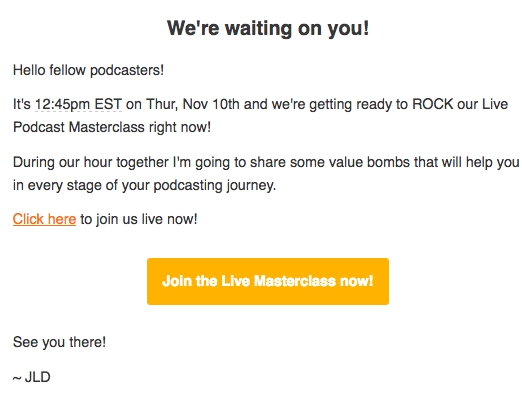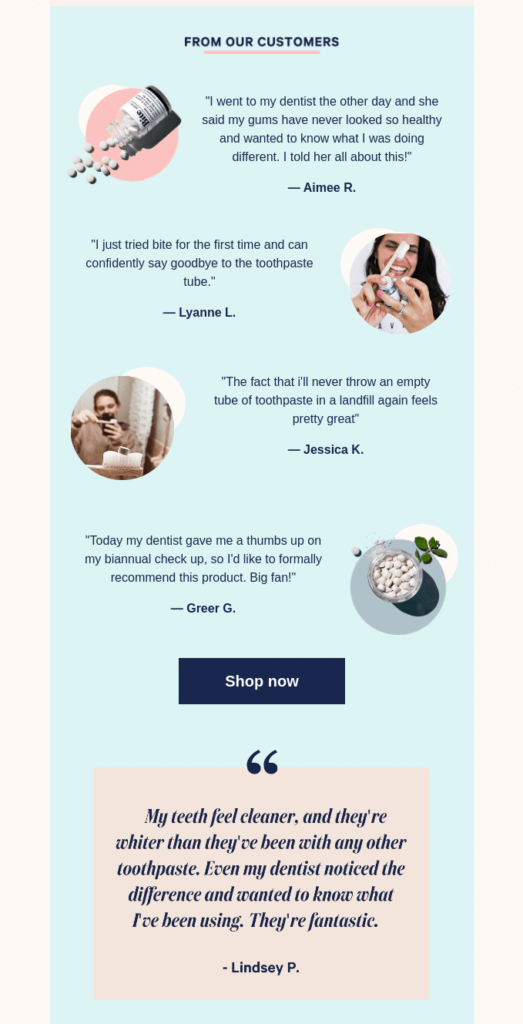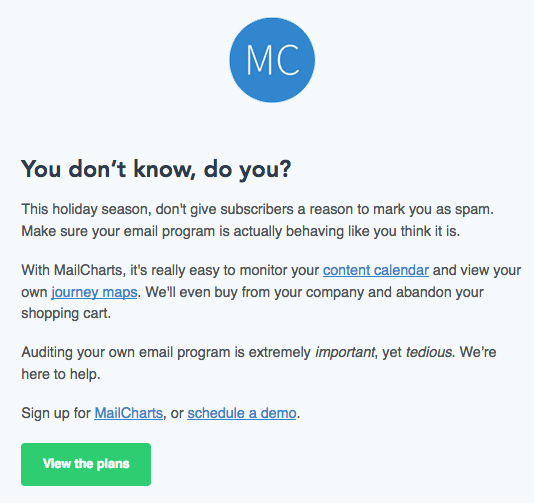17 Powerful strategies to increase click-through rate in email marketing
By Sean Tinney April 4, 2024
Are you frustrated with crafting what you think is the perfect email, only to see it fall short when it comes to getting clicks? You’re not alone.
Picture this: You’ve nailed the subject line, you’ve hooked your readers with enticing content, and you’ve hit send with high hopes. But then, crickets. Your open rate looks good, but where are the clicks?
If you’ve ever found yourself scratching your head over this conundrum, you’re in the right place. We’re going to dive deep into the world of email marketing to uncover the secrets to boosting your click-through rate.
Get ready to learn how to turn those opened emails into action-packed click-throughs that drive results.
How to improve email click through rates
1. Stick to one main call to action per email
When you’re creating an email, it may be tempting to include multiple calls to action (CTA) buttons in the hopes that your subscribers will respond to at least one of the offers in an email. After all, the more options you provide, the more likely they’ll engage with one of them, right?
Well, not exactly. In fact, this can hurt your click rates rather than help them.
Too many CTA buttons can distract and overwhelm your subscribers, decreasing click-through rates in your emails. To get optimal click through rates, include one call to action button in your emails to focus your subscribers on taking a single action.
In the email below from EOFire, there is one clear call to action and no question of what the subscriber is supposed to do – join the class.

2. Segment your emails
Different people have different interests. So do your email subscribers.
If you send the wrong people on your list an offer they’re not interested in, your click through rates will most likely plummet.
For higher click-through rates, segment your subscribers and send tailored emails based on their interests. You’ll see better click through rates when you send the right offer to the right person.
3. Create a sense of urgency
The fear of missing out (FOMO) is real, and eliciting this feeling in your subscribers can influence them to click on your calls to action right away.
If you have an offer that ends soon or a limited number of spots at a webinar, for example, you can create a sense of urgency by adding words like “now” or “today” to your emails.
4. Personalize your emails
Have you ever received an email that didn’t apply to you at all? This kind of email may leave you feeling like a nobody on a huge list of email subscribers. And this feeling of alienation doesn’t encourage you to click.
Instead, when your subscribers receive an email for you, they should feel like you are addressing them alone. Truly personalized emails will feel like something written just for you. That kind of connection leads to higher click through rates.
Here are a few simple ways you can personalize your emails:
- Include your subscriber’s name in your email. While this technique isn’t fresh, it can be effective. Instead of adding subscribers’ names at the beginning of an email, try adding them in the middle or at the end.
- On your email sign up form, ask for information about your subscribers’ interests. Then, send segmented emails based on their responses.
- Collect your subscribers’ birth dates on your sign up form and send them a celebratory email on their birthday.
- Send emails tailored to what you know about your subscribers. What did they buy from you recently? Do you have something similar they may like? Send an email with a suggestion.
5. Create mobile-optimized emails
85% of people access email from their phones.
And that means if your emails are difficult to read on a phone, there’s probably a huge percentage of your subscribers who aren’t getting the best experience and are most likely not clicking on your emails.
To make sure your emails are easy to read from any device, use email templates that are mobile responsive instead of mobile-friendly.
Mobile responsive emails are easier to read on both desktops and mobile devices, because text, images and buttons automatically adjust to fit the screen size. Additionally, multi-column email layouts adjust to single columns on mobile devices, and content is easy to access with both a mouse and a touchscreen.
Mobile friendly emails, on the other hand, scale down to fit the size of the screen, but don’t adjust layouts or fonts.
See how this mobile-friendly email below is difficult to read because the double-column layout makes the images, fonts and headlines too small?

Compare that to this mobile-responsive email below, where fonts and images are resized for the small screen and double columns turned to single columns:

If you’re not an email designer and have no idea how to make an email responsive, fear not! Most email service providers (like AWeber) automatically have the emails you create mobile-responsive. But send yourself a test email to verify.
6. Include colorful, clickable buttons
One of the simplest ways to improve click-through rates is to ensure your subscribers know where to click. While plain text calls to action work for some people, a big button with a contrasting color immediately draws attention and can significantly improve click-through rates.
7. Don’t over complicate your email design
Complex isn’t always better, and this is often the case with email design. Avoid overwhelming your subscribers with an overabundance of images, icons or different fonts. Not only does this make for a disharmonious email, it’ll also take attention away from the content of your email and your call to action.
This beautiful, yet simple email from You Need a Budget incorporates a clean font, one image that works with the content of the email and a clear call-to-action button:

8. Use action-oriented CTA copy
Your email call to action copy should encourage people to take a specific action. Instead of using a generic call to action like “click here,” use verbs that describe the action you want subscribers to take, such as:
- Shop
- Learn
- Get
- Grab
- Submit
- Send
- Start
- Try
- Reserve
- Take
- View
- See
- Watch
- Read
By doing so, you’ll frame the subscriber experience in a way that influences them to want to take action.
9. Pique their curiosity
“The first and simplest emotion which we discover in the human mind is curiosity.”
– Edmund Burke
Everyone has been curious about something at one point in their lives. And when a person is curious about something, they are inclined to resolve their curiosity.
Fortunately, you can also leverage curiosity in your email copy to encourage people to click-through on your emails.
Birchbox, for example, does this in the email below by offering a free mystery prize with a purchase. To find out what they would get, they need to click on the call-to-action button.

Hopefully the prize is a good one, but at least it gets the click!
10. Include social proof
Believe it or not, people like to do what other people do. When they notice multiple people or a famous person doing something, they’re more likely to want to do it themselves.
This is called social proof, which is a phenomenon where people are persuaded to take an action by seeing that other people have taken that action before them—and have seen success as a result of that action.
You can use social proof in your email content to encourage people to click through your calls to action.
Bite does just that in the email below. By showing off how customers use their product and sharing their success stories, they tap into the power of social proof.

11. Write engaging headlines
If you use a headline in your email content, it will be the first thing your subscriber sees when they open your message.
A good headline quickly grabs your subscriber’s attention, engages them and gets them to read the rest of your email. And when subscribers read your email content, they become more likely to take action – which makes headlines pretty darn important.
For the email below, MailCharts used the subject line “Are your subscribers annoyed??” and then followed it up with the headline “You don’t know, do you?”

By linking the headline to the subject line, it guides the subscriber to continue reading through the rest of the content. You’ll also notice MailCharts does a good job of raising curiosity, which gives readers even more of a reason to continue reading and click the call-to-action button.
12. Use video
People love videos. They’re engaging, easy to follow, and often fun to watch.
While video doesn’t play in all inboxes, the inclusion of a thumbnail image of your video and a play button can boost click through rates tremendously. In fact, Wistia increased their email click through rates by 300 percent by incorporating videos in their emails.
Bonus tip: You can also try using GIFs in your emails to add motion to your emails and boost click-through rates.
13. Cater to what your audience likes
If one of your emails had an insanely high click through rate, it’s apparent that your subscribers liked what you did in that email. So, do it again.
Your audience should be your main barometer for what is working in your email strategy and influence the content and design elements you include.
Do you see high click through rates when you send short emails or long emails? Does your audience click more when there’s an image or video? Does a certain kind of content lead to higher clicks?
Take a look at your past emails and see which ones got the highest click through rates.
Then, repeat, repeat, repeat.
Have two (or three) ideas for one email? Split test them. See which version of the email wins and do it again.
14. Feature the right images
Images in your emails can be a powerful way to grab the attention of your subscribers and convince them to click. However, you need to use the right images.
Email images should add meaning, support the content of your email or help make a relevant point. Additionally, you should use alt text in case your images don’t display.
Check out the header image in the email below, which serves multiple purposes:

There are a few things that work well here.
- It summarizes the content of the email briefly and immediately, giving the reader everything they need to know in the space of a few seconds.
- The image supports the content of the email and provides additional meaning.
- Finally, it includes a call-to-action button, which encourages people to click on the email.
For the subscriber who skims or doesn’t read the email content, this image does it all. It catches their attention, tells them about the offer and gives them a place to click.
15. Set expectations early
To set a good foundation for your emails (and help your engagement rates start off on the right foot), you’ll want to make sure subscribers know what they’re signing up for before they give you their email address.
Whether it’s a monthly newsletter, weekly do-it-yourself tips or seasonal exclusive offers, being upfront about the kind of emails readers will receive helps attract the right people to your list. Plus, it sets expectations as to what you’ll be sending them – as a result, there shouldn’t be any unwanted surprises.
16. Experiment with the frequency and timing
Depending on your target audience and the content they prefer, the frequency and timing of your messages could vary greatly.
You may find a weekly email newsletter is a great place to start. Eventually, you can increase the frequency of your emails to promote your product, share content or break your newsletter into smaller chunks. Or, ask your subscribers what cadence they prefer.
Try experimenting with time frames to figure out when your audience is most likely to read your email.
You can use analytics to determine when people are most likely to open your emails and plan your campaign accordingly.
17. Craft a strong subject line
Strong subject lines impact click through rates just as much as open rates. Your email could contain the best content ever, but no one will read it if your subject line is weak.
Most people skim through their inbox, so make sure your subject line is short and punchy.
Adding a special offer, asking a question, or emphasizing a sense of urgency, for example, can all be effective ways to create a compelling subject line.
Of course click through rates are important, but open rates and other forms of email engagement can contribute to your email marketing success. Make sure you track your email engagement metrics to learn what works for your unique audience.
Commonly ask questions for email clicks
What is an email click-through rate?
Click-through rates reveal how many subscribers clicked a link in an email, as well as how many times they clicked it. Your click-through tells you if people are engaging with your emails.
What is a good click-through rate for email?
A good email click-through rate will vary by industry and type of email, but on average a good click-through rate is about 2.5%.
Overall, an email marketing benchmark will vary widely among industries, business size, audiences, and more.
What is the average click-through rate of an email?
To better understand small business email marketing benchmarks, we conducted research asking survey respondents to self-report their click-through rates. Overall we found that 77% of small businesses have an average email click-through rate between 0% – 10%.

While it’s nice to get an idea of how your metrics stack up against others’, I would encourage you to change the way you view email marketing benchmarks.
Rather than comparing your email click-through rates to other businesses’ rates, keep an eye on how your rates improve over time. You’ll learn a lot more about your particular audience by focusing on your own data.
After all, it’s true that ‘comparison is the thief of joy.’
But, you should know that low click-through rates can tank a product launch, hurt your website traffic, and make your email strategy ineffective.
Want to make sure this doesn’t happen? Try these 14 ways to optimize your emails and get more clicks.
How to calculate email click through rate?
Email click-through rate is calculated by dividing the number of people who clicked a link in the email by the total number of emails sent.
Go get yourself a sick amount of clicks.
Try these tactics with your subscribers and see what increases click-through rates. Tell us what worked in the comments below!
(You’ll need an email marketing platform to apply what you learn in this post. Try AWeber’s easy-to-use email platform for free.)
Leave a Comment